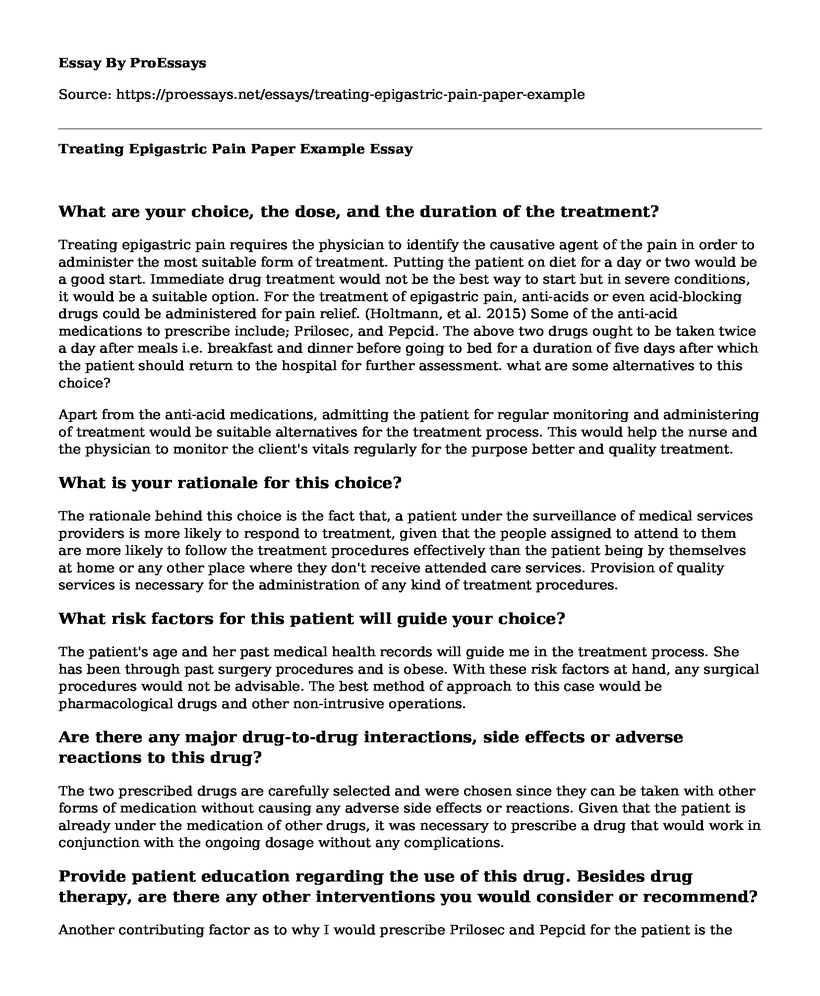What are your choice, the dose, and the duration of the treatment?
Treating epigastric pain requires the physician to identify the causative agent of the pain in order to administer the most suitable form of treatment. Putting the patient on diet for a day or two would be a good start. Immediate drug treatment would not be the best way to start but in severe conditions, it would be a suitable option. For the treatment of epigastric pain, anti-acids or even acid-blocking drugs could be administered for pain relief. (Holtmann, et al. 2015) Some of the anti-acid medications to prescribe include; Prilosec, and Pepcid. The above two drugs ought to be taken twice a day after meals i.e. breakfast and dinner before going to bed for a duration of five days after which the patient should return to the hospital for further assessment. what are some alternatives to this choice?
Apart from the anti-acid medications, admitting the patient for regular monitoring and administering of treatment would be suitable alternatives for the treatment process. This would help the nurse and the physician to monitor the client's vitals regularly for the purpose better and quality treatment.
What is your rationale for this choice?
The rationale behind this choice is the fact that, a patient under the surveillance of medical services providers is more likely to respond to treatment, given that the people assigned to attend to them are more likely to follow the treatment procedures effectively than the patient being by themselves at home or any other place where they don't receive attended care services. Provision of quality services is necessary for the administration of any kind of treatment procedures.
What risk factors for this patient will guide your choice?
The patient's age and her past medical health records will guide me in the treatment process. She has been through past surgery procedures and is obese. With these risk factors at hand, any surgical procedures would not be advisable. The best method of approach to this case would be pharmacological drugs and other non-intrusive operations.
Are there any major drug-to-drug interactions, side effects or adverse reactions to this drug?
The two prescribed drugs are carefully selected and were chosen since they can be taken with other forms of medication without causing any adverse side effects or reactions. Given that the patient is already under the medication of other drugs, it was necessary to prescribe a drug that would work in conjunction with the ongoing dosage without any complications.
Provide patient education regarding the use of this drug. Besides drug therapy, are there any other interventions you would consider or recommend?
Another contributing factor as to why I would prescribe Prilosec and Pepcid for the patient is the fact that the two drug dosages are relatively easy to follow. Failure to take the dosage at the required time has no serious side effects. However, I would advise the patient to only take the recommended dose and not more even id the pain still persists. In case the symptoms still persist even after taking the medication, I would advise the patient to return for further diagnosis and treatment.
References
Holtmann, G., Rich, G., Wieland, V., Funk, P., Kieser, M., & Koehler, S. (2015). Menthacarin for the Treatment of Epigastric Pain Syndrome (EPS) and Postprandial Distress Syndrome (PDS): Data of a placebo-controlled trial revisited. Zeitschrift fur Gastroenterologie, 53(08), KG253.
Robinson, P., & Perkins, J. C. (2016). Approach to Patients with Epigastric Pain. Emergency Medicine Clinics, 34(2), 191-210.
Shih, M. C. P., & Hagspiel, K. D. (2007). CTA and MRA in mesenteric ischemia: part 1, role in diagnosis and differential diagnosis. American Journal of Roentgenology, 188(2), 452-461.
Rispa, D., & Rani, K. S. (2018). CASE REPORT ON EPIGASTRIC PAIN CAUSED BY DICLOFENAC IN OSTEOARTHRITIC PATIENT.
Cite this page
Treating Epigastric Pain Paper Example. (2022, Sep 22). Retrieved from https://proessays.net/essays/treating-epigastric-pain-paper-example
If you are the original author of this essay and no longer wish to have it published on the ProEssays website, please click below to request its removal:
- Protect Yourself Against HPV Essay
- Essay on Leadership in Emergency Preparedness Planning
- Questions and Answers on Nutrition Case Study
- Paper Example on Congestive Heart Failure: A Growing Epidemic
- Disability in Higher Education: The Self-Identification Challenge- Essay Sample
- Health Perception and Its Influence on Nursing Practice: A Care-Based Perspective - Essay Sample
- Paper Example on Airline Flight 1420: NTSB Report, Causes & Recommendations







